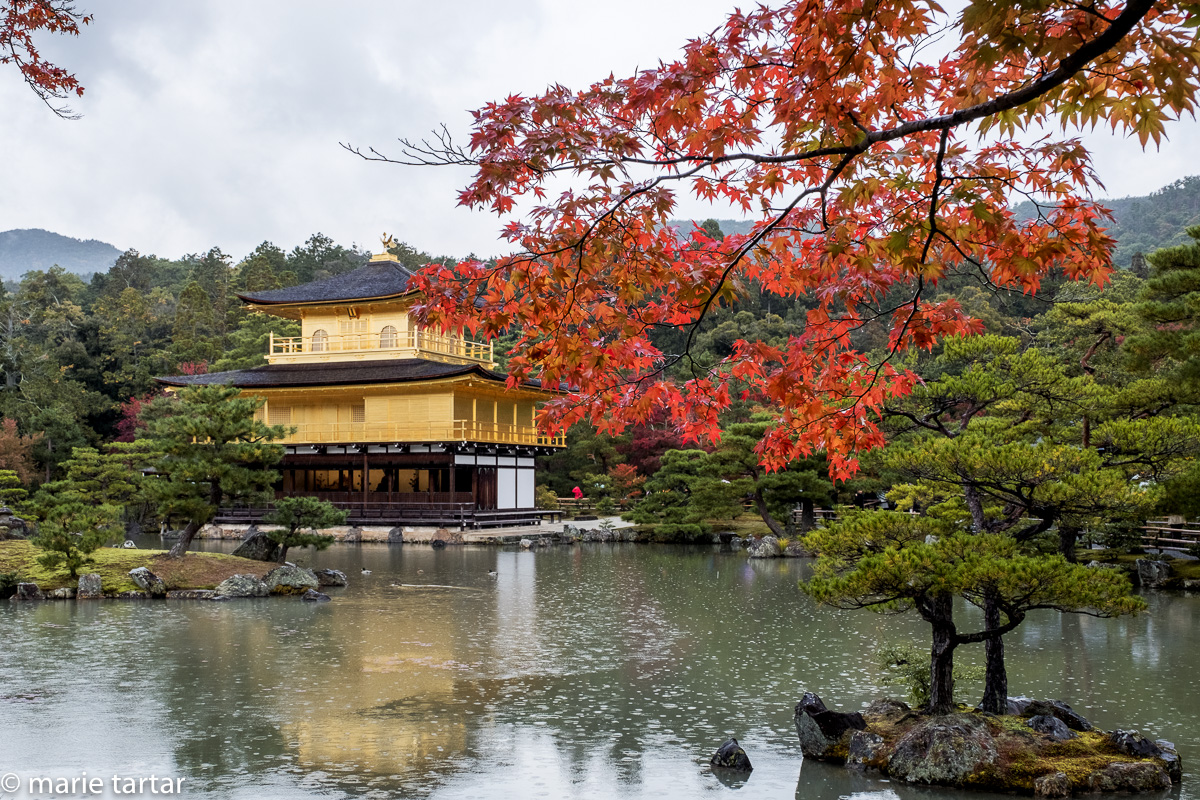
Saturday, October 29, 2016-Sunday, October 30, 2016
In recent years, Japan has become a favorite destination. What’s not to like?! Besides an efficient, comprehensive transportation system, delicious and healthy food, gorgeous gardens, and a mind-blowing juxtaposition of traditional with cutting-edge contemporary, it is safe AND reachable by a single non-stop flight from San Diego! Combine that with a Collector’s salon trip with MOPA (Museum of Photographic Arts) providing access to artists, galleries and museums; mochiron, we signed on! We weren’t the only San Diegans heading to Japan this fall; a group from MCASD (Museum of Contemporary Art SD) was headed over at the same time, including multiple friends. Our friend Gordon, an avid collector of contemporary Japanese ceramics, beat us all there, posting dispatches in the days leading up to our departure.
This would be a 4-part harmony. The MOPA trip was split between Tokyo and Kyoto; Kyoto we know and love, Tokyo we know less well, but were looking forward to adding depth to our prior explorations. The timing required us to take 2 weeks off, leaving a few days before and after the group trip for us to wander further afield. Our final stay was decided by the good fortune of being able to book 2 consecutive nights at Naoshima Island, which we had enjoyed too briefly in 2014, thanks to an untimely typhoon. I debated between Nara and Kanazawa for our opening sojourn, and left it to Steve to decide; he chose Kanazawa. Meeting architect and photographer Wyn in Seattle in February undoubtedly swayed us toward Kanazawa, thanks to his enthusiasm for the 21st Century Museum there, crystallized in an ethereal image he had gifted us. Kanazawa is easier to reach than in the past, being linked by shinkansen to Tokyo as of 2015, speeding our journey to meet up with the MOPA group in Tokyo.
Our travel weekend started early, with a 7 am airport pick-up. A highlight of the trip over was finding a new film by Japanese director Kore-Eda, a quiet yet luminous family drama, “After the Storm”. A formerly promising novelist struggles with his ghosts of a ne’er do well father and his own gambling predilection while trying to maintain a relationship with his son after his divorce. A typhoon brings the fractured family under the same roof for an evening of reckoning with past promises and future possibilities.
For a small premium, bulkhead seats were ours. Amazingly, the plane wasn’t full, leaving a completely empty back row of 4 unoccupied seats, which I eventually commandeered for a few hour snooze. Just as I was drifting off, a friendly stewardess leaned over to remind me that should a passenger become sick, they would need to bump me. No problem, I thought drowsily, I’ll be attending them…..thankfully, this didn’t happen.
Because we’d be returning from Naoshima, I opted to fly into Kansai, necessitating flying up to LAX. I chose a hotel in the Shin-Osaka station, reachable by train without transfers from Kansai, simplifying our departure for Kanazawa the next morning.
Monday, October 31, 2016 (Halloween)
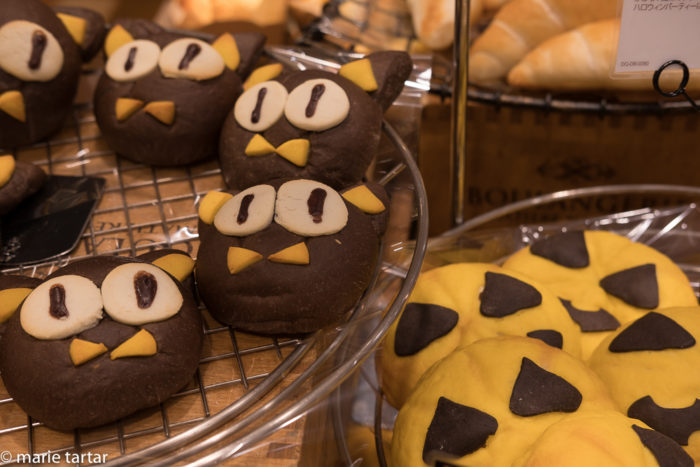
Japanese bakery interpretation of Halloween, in Kanazawa… jack o’ lanterns to the right, but on the left…Felix the Cat??
Our transfer to Kanazawa went smoothly. We had activated our 2 week JR rail passes at the airport the night before, eliminating the need to stand in the JR office line. After dancing around each other, a small hotel room version of Twister, trying to dress and pack in our well-outfitted but small space at remm Shin-Osaka, we were done with breakfast in the 3rd floor restaurant before 9 am. The Thunderbird Express thundered its way north via Kyoto and then Fukui, landing us in Kanazawa before noon.
Kanazawa is a very walkable small city, sometimes called “Little Kyoto”. Like Kyoto, it was spared bombing during WW II , preserving historic samurai and geisha districts. Most of the destinations of interest to tourists can be reached by the counter-clockwise running left- hand bus, with the opposite, right-hand bus heading back to the station. Following instructions provided by Japan Experience, we hopped on the left-hand bus for 4 stops, disembarking at Kata-machi, then had a short walk across a bridge spanning the Saigawa river to the well-situated house. Chris, our “travel angel”, was already there to orient us to the Sennichi house, our accommodation for the next 3 nights. He is the driving force behind “Kanazawa Underground”, a mostly online resource for “everything not in your Ishikawa guidebook”. He proved to be a good resource for restaurant and activity ideas, and was especially helpful in making reservations for us. I had initially thought it a little odd that the Japan Experience website did not seem to allow the option of not engaging the “travel angel” services ($50), but ended up finding it useful. Also strange to me was the separate, although nominal ($20), charge for linens-are there really people who travel with their own sheets?
Procrastinating can sometimes work in one’s favor. We decided relatively late on the Kanazawa leg of our trip. I was surprised I was able to book this house only one month in advance-it turns out this house is the newest addition to Japan Experience’s options in Kanazawa and had only recently been renovated. It is a small 2 bedroom house, with 2 tatami rooms upstairs, and living room, kitchen and dining room and bathroom facilities downstairs, looking out to a small enclosed garden. Attractive and comfortable, it could house 2 couples and would be a very cost-effective alternative to a hotel. Even with just 2 of us, it was under $200/night, about the same as a hotel but with a lot more space and a kitchen.
Many years ago, we did a Backroads biking trip to the Noto peninsula, north of Kanazawa and we spent a night in Kanazawa at the beginning of the trip. At least, we think so, but we did not recognize anything! We started our stay with a walk in the famous garden, Kenroku-en.
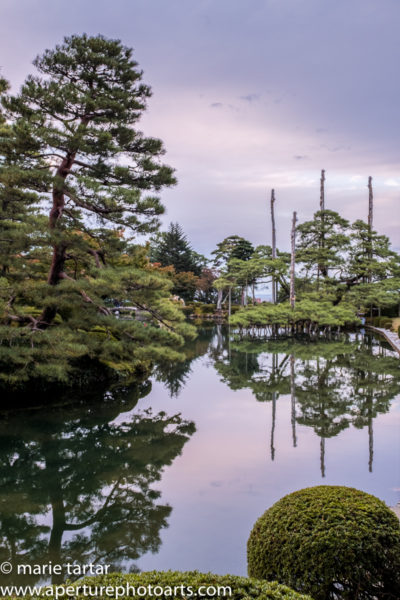
Kenroku-en Garden, in Kanazawa, Japan, in fall, just before the full unfurling of yukitsuri (the poles in the background) used to bolster tree branches against the weight of winter snows
Although the fall color was not as vibrant as I had hoped for, our timing was good in terms of seeing the annual erection of the yukitsuri, the conical supporting lattice used to support pine branches weighted down with winter snow. Over the succeeding days, we saw daily progress, culminating in the supports being completed unfurled on our final garden stroll 2 days later.

Kenroku-en Garden in Kanazawa, Japan, is one of Three Great Gardens of Japan. The “roku” part of the name means 6 and refers to six elements incorporated in an ideal garden: spaciousness, seclusion, artifice, antiquity, waterways, and panoramas
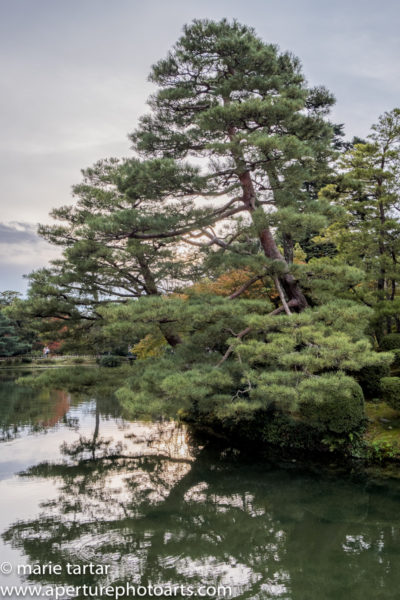
Elements of Kenroku-en Garden in Kanazawa date back to the 1620s; successive lords put their touches over the centuries on the evolving garden, which opened to the public in 1874

Kenroku-en definitely has the “panorama” component of an ideal garden; here, views of Kanazawa from the elevated garden
For dinner, we went with one of Chris’ recommendations, Hachijuuyon (or 84)-banchi, named for its street address, which was walking distance from the house.
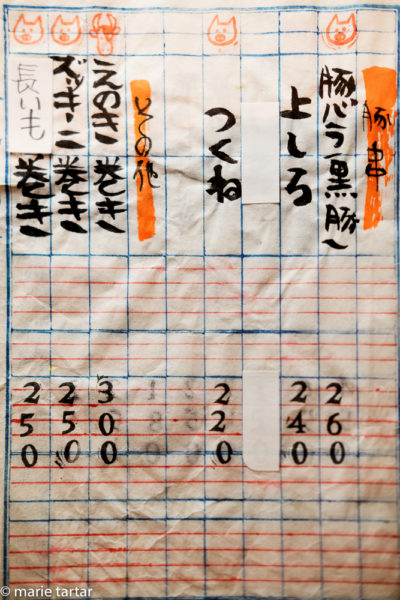
Japanese menus can be tough to decipher…Menu at Hachijuuyonbanchi in Kanazawa; those little faces up top? Not cats, but pigs, with one cow in the mix
A nearby “konbini” (convenience store) yielded an example of a local sake Chris had mentioned, Tedorigawa, to sample.
Tuesday, November 1, 2016
As usual, jet lag had me up early, by 5 am. I crept downstairs to read, Steve needing to make up his sleep deficit from the trip over. We spent the morning in the Temple district, including the so-called Ninja Temple (Ninja-dera, or Myouryuji; literally, oddly built temple), weighing Chris’ opinion that it was interesting historically and architecturally against our friend Gordon’s that it was a money-wasting tourist trap. We were able to make reservations on the spot and joined a tour group with school kids and other tourists. The temple is a labyrinth of hidden staircases and secret exits, architectural elements designed to foil an invasion.
At noon , we were scheduled for a special lunch, Machiya Kaiseki Rocca, a recommendation from my Japanese teacher, Yoko, a Kanazawa native. She had mentioned it was a favorite of her family, but that it might be tough to secure a reservation since being awarded 2 Michelin stars. So, I put Chris on the case when we arrived. We took the bus to the station, and walked from there. The building is more than 125 years old and is a former sake brewery.
I lost count of the number of exquisite, small plates, at least 8 courses. My favorites were the rice with mountain vegetables (especially the second helping, with a golden crust), chawanmushi (egg custard) with chestnut sauce, duck with chrysanthemum sauce, and the dessert of carrot-ginger sorbet with red bean paste and jelly. Along the way, there was sashimi of squid, shrimp and fluke, conger eel sushi, persimmon salad, 2 versions of miso soup, and a walnut tofu starter. At 60,000 Yen per person, about $60 USD, it was half the price of dinner.
We walked back by way of Omicho Market.
In the afternoon, we wandered through the historic samurai district. For dinner, we foraged in a depachika, basement food emporium of Daiwa depaato (department store), sharing okinomiyaki, supplemented by shoyu infused daikon and seaweed salad at home.
Wednesday, November 2, 2016 was an action-packed day! The rain of the prior day was swept away and the day was cool and brightly sunny. We started the day by returning to Kenroku-en Park, hoping for better light than on our gray arrival day. We had a lot more company, mostly Japanese tourists and lots of school children too, in their matching colorful caps.

Adorable school kids in their uniforms; junior high age girls wear a sailor-style navy outfit with pleated skirts that looks completely unchanged from my mother’s school days in the 1950s!
We had seen lines of children being walked by their teachers along the river near the house on the way, bringing to mind Chinese photographic artist Yu Xiao, whose work in friends’ collections we had recently seen.
We had an early lunch in the cafe at the 21th Century Museum, before exploring the curved glassed structure by SANAA. Steve was surprised to receive crustless egg salad and ham and cheese sandwiches instead of the melty breakfast ham, cheese and egg McMuffin style concoction he was expecting. I was happy with my seasonal mushroom curry with rice.

In the galleries, the citizens come and go, talking of Michelangelo…one of the few lines of poetry I consistently remember (T.S. Eliot’s “The Love Song of J. Alfred Prufrock”), in Kanazawa’s 21st Museum of Contemporary Art
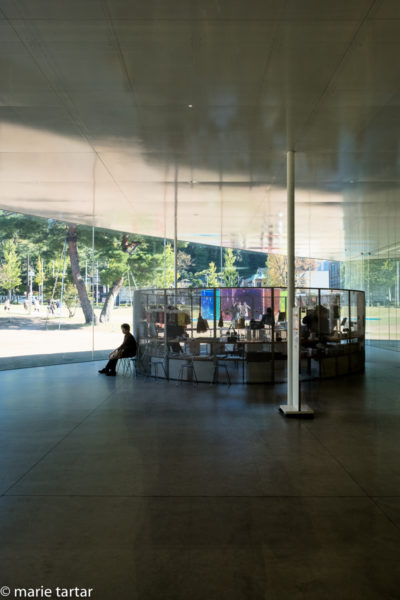
Kanazawa’s Museum of 21st Century Art is semi-circular, with much of the lawn and the outer perimeter seeming to function as a giant park or outdoor living room
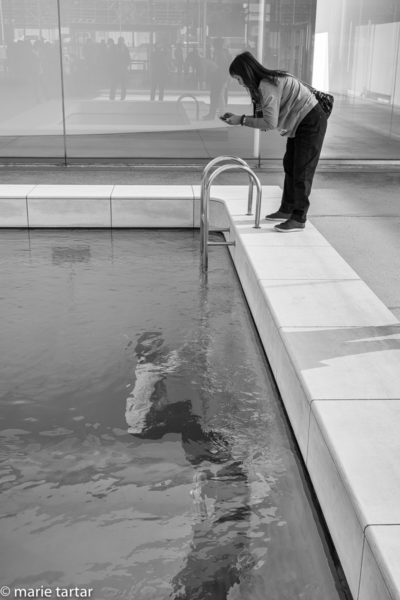
One of the more popular art installations at the Kanazawa 21st Century Museum of Contemporary Art: a “pool” by South American artist Leandro Erlich: fully clothed visitors inside the “pool” are in a ticketed gallery below
Steve’s stomach (or his nose’s memory) drove us across town back to the bakery Chris had recommended, Bistro Hiramipan, which had turned us away for lunch (too late) the day before. It again smelled wonderful. It was filled with well-turned out ,mostly young, Japanese women, who appeared firmly engaged with their lunches and friends and not likely to yield one of the coveted tables in this small haven. After learning the wait was on the order of an hour, I negotiated tasty take-out sandwiches (pork, cheese, carrot, mushroom) and we decamped to a bench in the sun in the nearby samurai warren.
After boarding a Flat Bus and learning it wouldn’t take us to our next destination, the D.T. Suzuki Museum, we walked back to the main drag to catch a Lefthand Bus. I was surprised to realize we had overshot our destination by one stop, arriving back at the 21st Century Museum. The exit was barred and the driver balked at opening it, indicating that I hadn’t signaled for a stop. The bus itself was stopped for passengers entering from the rear of the bus, but evidently, it was not routine for the front door to be opened for exiting passengers unless they signaled. I hadn’t signaled because I heard someone else signal for the stop, but the bus didn’t stop. Puzzling, but no matter, this just made our walk a few blocks longer.
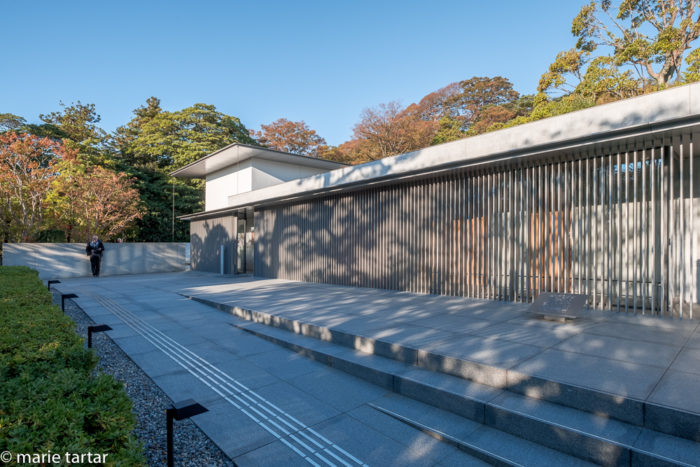
Yoshio Taniguchi designed D.T. Suzuki Museum in Kanazawa, near the birthplace of the man whose writings and translations introduced Zen Buddhism to the West.
The D. T. Suzuki Museum was a real revelation.
It opened in 2011, the work of Yoshio Taniguchi, best known in the US for his expansion and remodel of the Museum of Modern Art in New York. It is a contemplative space, intended to introduce visitors to the life and work of the Buddhist philosopher and scholar, whose writings introduced Zen Buddhism to Western audiences.
From the museum, we headed back to the Kenroku-en garden for the best light yet, late afternoon spun gold. The workers erecting the supportive lattices of rope over the sculptural pines were making progress. The yukitsuri have become a winter symbol of Kanazawa.
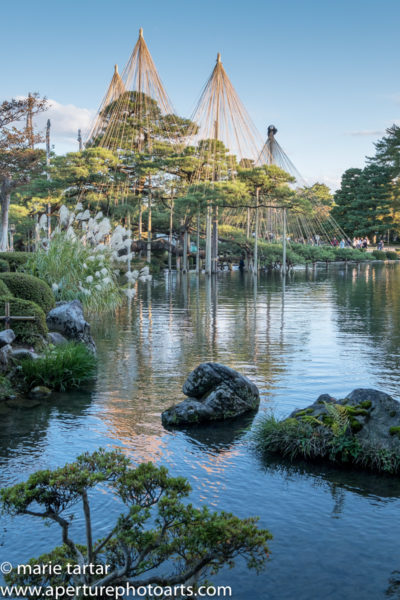
From poles to protective cones, the yukitsuri blossomed over the famous pines of Kenrokuen Gardem during our stay in Kanazawa in early November
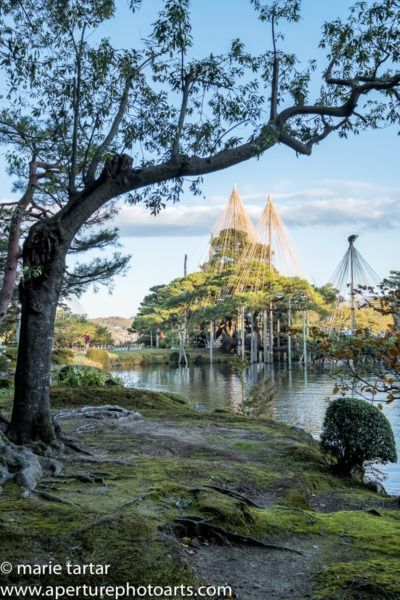
Almost done! A worker puts the final touches on the yukitsuri on the far right, readying the famous pines of Kenroku-en Garden in Kanazawa for winter
We cabbed across town to the Higashi Chaya geisha district, where a queue had already formed for the evening’s narrated geisha performance at Kaikaro, a historic teahouse dating to 1820.
It is owned by Lady Baba, who introduced the songs and performers, including a shamisen player and singer, accompanied by a dancer. She later joined them playing a Japanese drum. This performance differed considerably from Miyako Odori, the spring geisha dance extravaganza we had seen in Kyoto in the spring. That was an all-out spectacle, visually stunning, ritually choreographed; this was more of a chatty demonstration. Audience members were involved, playing the drums and competing in a form of rock-paper-scissors, in which the loser had to take a sake shot.
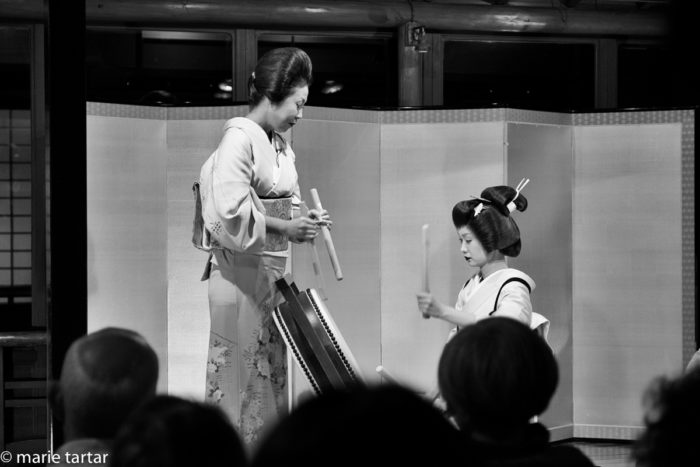
An evening at Kaikaro in Higashi Chaya, a geisha district in Kanazawa, with Lady Baba (left) accompanying a geiko on drums
For our final dinner in Kanazawa, we had Chris call Yamashita, highlighted earlier this year in the New York Times as emblematic of a post-Japanese recession new generation of innovative chefs. We ordered a la carte, the tasting menu at $100 per person suggesting the prices had risen significantly since the article, which estimated dinner with drinks at $40. The grilled shitakes arrived over a miniature ceramic hibachi. Brushed with shoya and grated ginger, they were sweet and succulent, plump and juicy, fleshy and superb. Matsutake mushrooms were featured in a broth in a miniature teapot. Kanazawa vegetables in vinegar, boiled crab and uni, and rice with pine nuts, ginko, mushrooms followed in succession. When the pot of rice arrived, we were reassured by our young, pretty and attentive waitress that we could take home the extra rice should the portion be too much for us to eat, but she evidently did not know with whom she was dealing!
Thursday, November 3, 2016
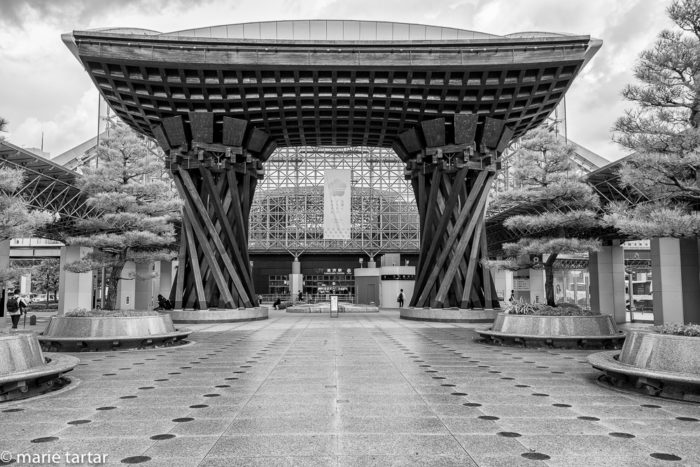
Kanazawa’s impressive Tsuzumi Gate evokes a wooden hand-drum and forms an imposing entrance into the train station; it made Travel and Leisure’s list of world’s most beautiful stations; I’d agree!
It was raining again when the Chris-arranged cab pulled up at 8 am to take us to the station. On the platform, I learned to my surprise that the shinkansen to Tokyo was a train with all reserved seats, something I hadn’t encountered before. Luckily, we were early, so back down the escalator to the JR office I scurried, leaving Steve with the bags on the platform. By mid-day, we were in Tokyo Station and on to the Tokyo and MOPA segment of this trip…to be continued…eventually!
-Marie
Next up: Tokyo!
https://aperturephotoarts.com/november-2016-japan-part-2-tokyo/
Save

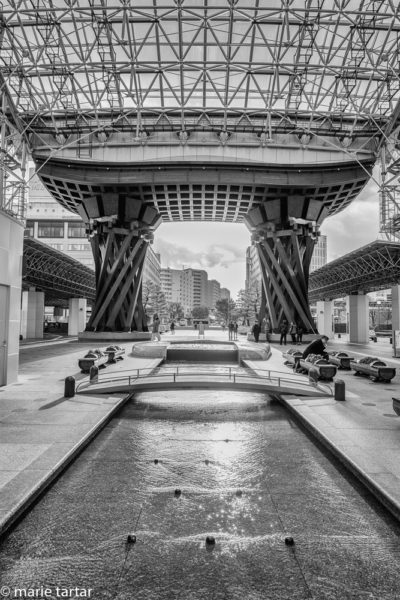
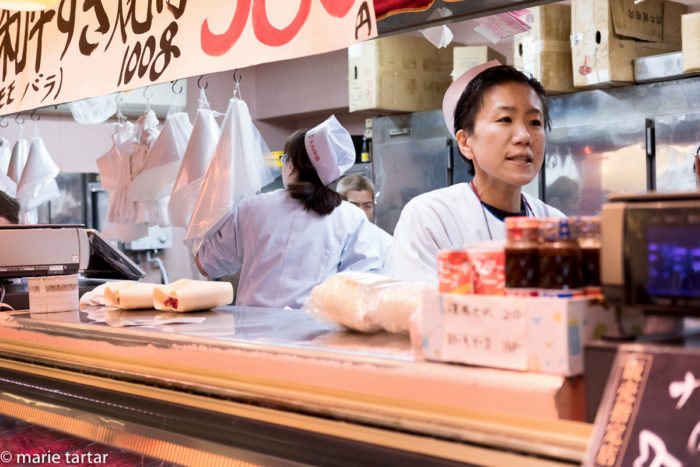

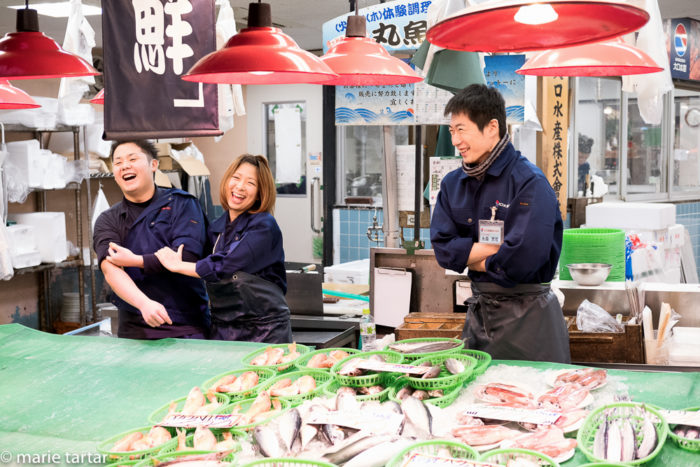
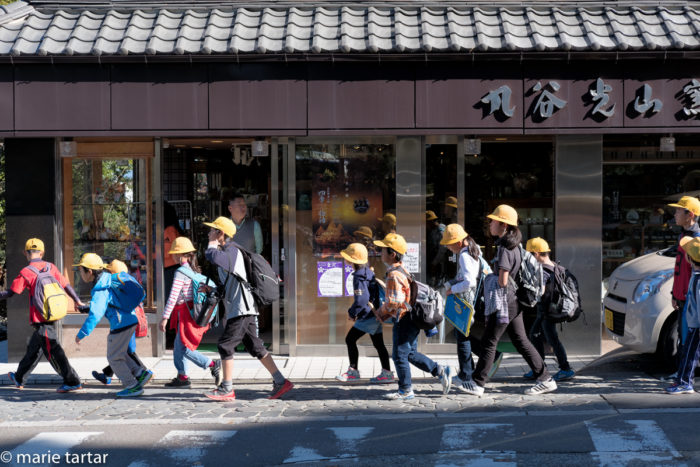
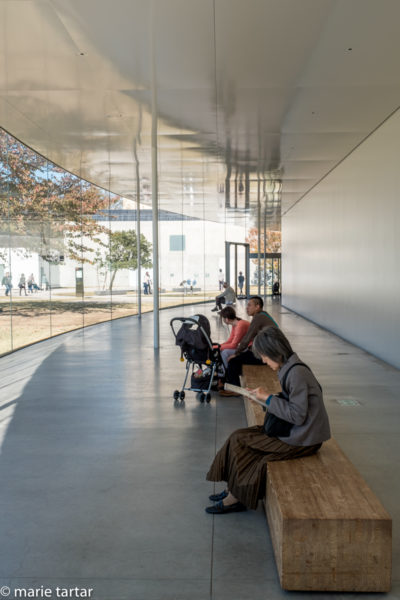

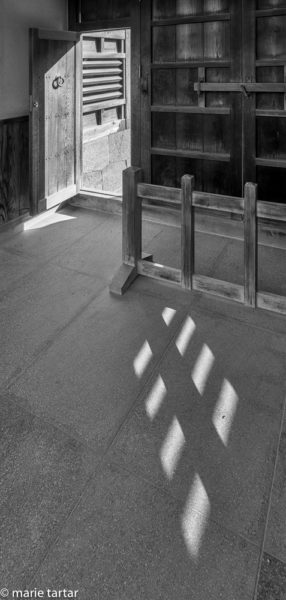


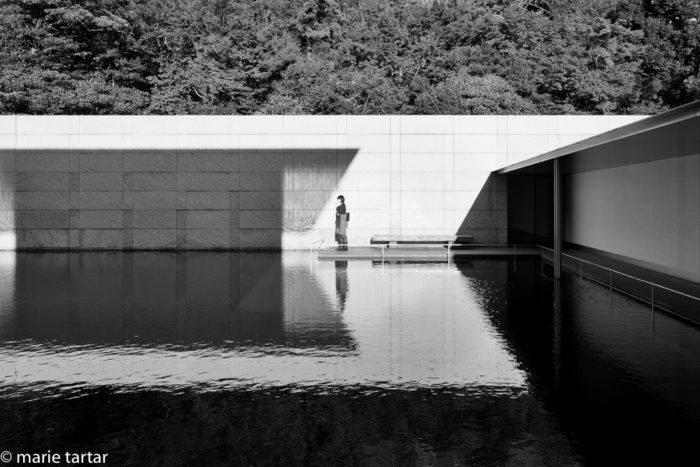
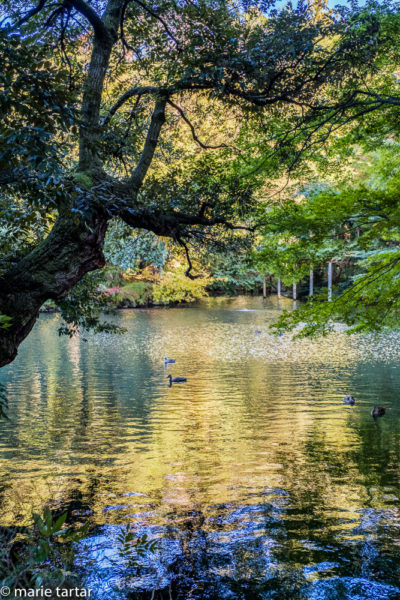

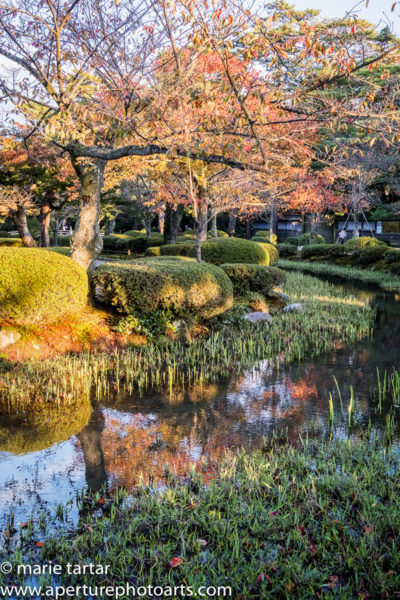
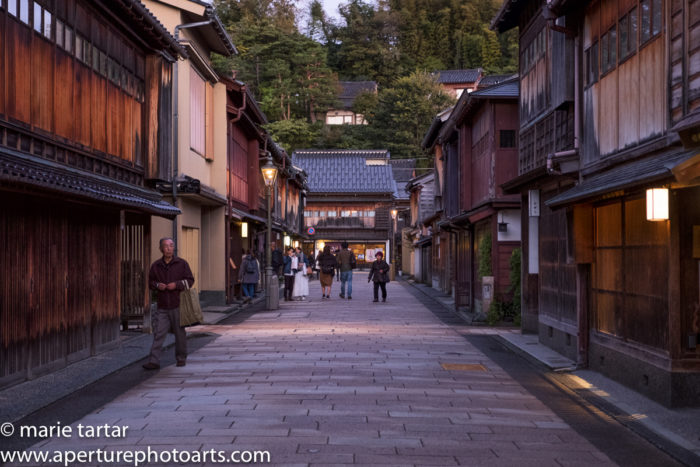
I love the winter supports for the trees!
It’d be wonderful to actually see the trees snow-laden!